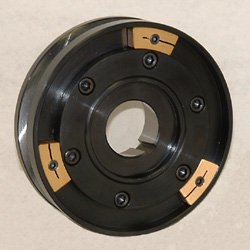ballen
Diamond
- Joined
- Sep 25, 2011
- Location
- Garbsen, Germany
I've got a couple of "new" hubs for my Studer RHU-450 grinder, but the balancing weights are missing. What's the easiest way to make new ones?
The wheels themselves are 300mm = 12" diameter, with a 127mm = 5" ID. The annular slot for the (missing) balancing weights is about 6mm (1/4") deep and has an inner radius of about 150mm (6 1/2") and an outer radius of about 165mm (6 1/2"). The slot is not tapered, it has parallel sides.
I was thinking about this for making the weights:
- turn a ring from 6mm steel which has the correct ID and OD to just fit into the slot
- cut off segments of the ring
- tap the segments for setscrews, using a taper tap but NOT going full depth, so that the threads are fully formed on the entry side but not on the exit side of the threaded hole
- slot the segments, with a slot that intersects the threaded hole
Is there an easier way? Will running a tap only partially in create the desired spread/lock action?
The wheels themselves are 300mm = 12" diameter, with a 127mm = 5" ID. The annular slot for the (missing) balancing weights is about 6mm (1/4") deep and has an inner radius of about 150mm (6 1/2") and an outer radius of about 165mm (6 1/2"). The slot is not tapered, it has parallel sides.
I was thinking about this for making the weights:
- turn a ring from 6mm steel which has the correct ID and OD to just fit into the slot
- cut off segments of the ring
- tap the segments for setscrews, using a taper tap but NOT going full depth, so that the threads are fully formed on the entry side but not on the exit side of the threaded hole
- slot the segments, with a slot that intersects the threaded hole
Is there an easier way? Will running a tap only partially in create the desired spread/lock action?




